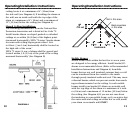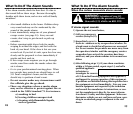
• A battery powered alarm must have a battery of the
specified type,in good condition and installed properly.
• A.C.powered alarms (without battery backup) will not
operate if the A.C.power has been cut off,such as by an
electrical fire or an open fuse.
• Smoke alarms must be tested regularly to make sure
the batteries and the alarm circuits are in good operating
condition.
• Smoke alarms cannot provide an alarm if smoke does
not reach the alarm.Therefore,smoke alarms may not
sense fires starting in chimneys,walls,on roofs,on the
other side of a closed door or on a different floor.
• If the alarm is located outside the bedroom or on a
different floor,it may not wake up a sound sleeper.
•The use of alcohol or drugs may also impair one’s
ability to hear the smoke alarm.For maximum
protection,a smoke alarm should be installed in each
sleeping area on every level of a home.
• Although smoke alarms can help save lives by provid-
ing an early warning of a fire,they are not a sub-stitute
for an insurance policy.Home owners and renters
should have adequate insurance to protect their lives
and property.
Carbon Monoxide (CO) Alarm
The carbon monoxide (CO) alarm monitors the air for
the presence of CO. It will alarm when there are high
levels of CO present,and when there are low levels of
CO present over a longer period of time. When a CO
condition matches either of these situations,the
alarm/voice message warning system will sound,and be
accompanied by the flashing red LED light.The carbon
monoxide sensor uses an electrochemical technology.
Smoke Alarm
The smoke alarm monitors the air for products of
combustion that are produced when something is
burning or smoldering. When smoke particles in the
smoke sensor reach a specified concentration,the
alarm/voice message warning system will sound,and be
accompanied by the flashing red LED light. The
smoke alarm takes precedence when both smoke
and carbon monoxide are present.
NFPA 72 states:Life safety from fire in residential occu-
pancies is based primarily on early notification to occu-
pants of the need to escape,followed by the appropri-
ate egress actions by those occupants.Fire warning
systems for dwelling units are capable of protecting
about half of the occupants in potentially fatal fires.
Victims are often intimate with the fire,too old or
young,or physically or mentally impaired such that they
cannot escape even when warned early enough that
escape should be possible.For these people,other
strategies such as protection-in-place or assisted escape
or rescue are necessary.
• Smoke alarms are devices that can provide early
warning of possible fires at a reasonable cost,however,
alarms have sensing limitations.Ionization type alarms
offer a broad range of fire sensing capabilities but are
better at detecting fast flaming fires than slow smolder-
ing fires.Photoelectric alarms sense smoldering fires
better than flaming fires.Home fires develop in
different ways and are often unpredictable.Neither
type of alarm (photoelectric or ionization) is
always best, and a given alarm may not always
provide warning of a fire.
Smoke Alarm Features
Carbon Monoxide Alarm Features
76


















